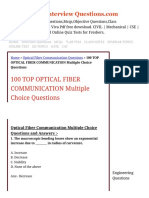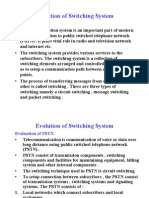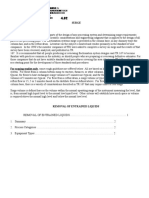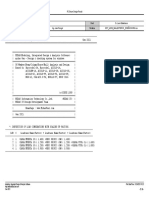Telemetry Question Bank
Telemetry Question Bank
Uploaded by
MATHANKUMAR.SCopyright:
Available Formats
Telemetry Question Bank
Telemetry Question Bank
Uploaded by
MATHANKUMAR.SOriginal Description:
Original Title
Copyright
Available Formats
Share this document
Did you find this document useful?
Is this content inappropriate?
Copyright:
Available Formats
Telemetry Question Bank
Telemetry Question Bank
Uploaded by
MATHANKUMAR.SCopyright:
Available Formats
DEPARTMENT OF BIOMEDICAL ENGINEERING QUESTION BANK COURSE: M.
E Biomedical Engineering SEMESTER: III
TELEMETRY
UNIT-1 PART-A 1. What is telemetry system? Draw the general block schematic of a telemetry system. 2. Write the classification of telemetry. 3. Define non-electrical telemetry and the types. 4. Write about modulation techniques. 5. Write the three cases of current for transmission. 6. Write about PCM and PFM. 7. Draw the basic scheme of waveform generation. 8. What is error rate and probability of error? 9. What is known as source coding and channel coding? 10. What are the types of time-function pulses? 11. Draw the scheme of a pulse duration system. 12. What is pulse amplitude modulation and write the output pulse? 13. What is signal-to-noise ratio? 14. What is tail or ringing? 15. Draw the time response with raised consine function. 16. What is mechanical telemetry system? 17. What is pneumatic telemetry system? 18. What is source coding? 19. What is pulse rate system? 20. What is pulse code system? 21. Write short note on line coding. 22. Write down the different approaches for decoding of convolution encoded data. 23. Mention the types of Pulse time modulation. 24. Write short note on ASCII. 25. Draw the block encoding scheme. PART-B 1. Define non-electrical telemetry and the types explain in detail 2. What is time-function pulses and explain each type with neat diagram. 3. What are modulation codes? Explain PAM, PCM, PFM, and PTM 4. Write a brief note on interference, error rate and probability of error 5. What are telemetry system and the basic system explain with block diagram 6. Explain the following. i) mechanical type telemetry system ii) Pneumatic telemetry system 7. Describe in detail about pneumatic telemetry system. 8. Explain the following. i) pulse duration system ii) pulse code system 9. Write brief notes on i) Pulse amplitude modulation ii) Pulse code modulation 10. Explain in detail about intersymbol interference.
UNIT-2 PART-A 1. What is frequency division multiplexed system? 2. Draw the scheme of the receiving side of FDM system. 3. Sketch the FM spectra at different modulation index. 4. Write short note on FM circuits. 5. Give application of phase locked loop. 6. What are the phase detectors circuits used in PLL? 7. What are PLL discriminator and how they are used in communication application? 8. Draw the basic of scheme of TDM telemetry system. 9. What are the other popular types of PCM system? 10. Write about slope integration type. 11. Write short note on digital multiplexer. 12. Draw the differential PCM encoder and decoder. 13. What is sigma-delta modulation? 14. Write short note on counter servo type. 15. Write down the types of telemetry system. 16. Write short notes on IRIG standards. 17. Draw the block diagram of multiplexing with subcarriers. 18. Draw the block diagram of chip based VCO circuit scheme. 19. Write short notes on VCO. 20. Write short notes on pulse averaging discriminator. 21. Draw the circuit of Quadrature FM detector. 22. Write short notes on PLL modulator. 23. What is clock recovery circuit? 24. Draw the clock recovery circuit. 25. What is DPCM? PART-B 1. Explain in detail about PLL discriminator and how they are used in communication Application. 2. Draw and explain about the transmitting and the receiving side of FDM system 3. Write briefly about IRIG Standards and FM Circuits 4. Explain and draw the block diagram of TDM-PAM/PM System 5. Write short note on i) digital multiplexer and ii) differential PCM 6. Draw the transmitting and the receiving side of a PCM telemetry system 7. Explain in detail about frequency modulation circuits. 8. Discuss IRIG standards in detail. 9. Explain in detail about synchronization in PAM/PM system. 10. Explain in detail about DPCM.
UNIT-3 PART-A 1. What are the types of communications? 2. Define parallel communication 3. What is the major technique used in modems? 4. What are QPSK and FSK? 5. Write short note on Quardrature Amplitude Modulation. 6. What are waveguide components? 7. Define H-bend and E-bend. 8. What are the properties of plane wave in free space? 9. Draw the Diagram representation of plane wave. 10. Define selectivity and sensitivity. 11. What are detector and its types? 12. Draw the unbalanced line equivalent. 13. What is ETR? 14. What is called as longitudinal voltages? 15. Draw the diagram of modem based data linking. 16. What is DPSK? 17. What are the basic functional blocks of a transmitter? 18. Draw the frequency stabilization of FM oscillator. 19. Write down the concept of line. 20. Write down the properties of plane wave in free space. 21. What are the types of binary modulated carriers? 22. What is PSK? 23. State the sequence for data transmission procedure. 24. Write short notes on Bisync protocol. 25. Draw scheme of AM transmitter. PART-B 1. Explain about the modems and any one major technique. 2. Write short note on PSK and DPSK. 3. Briefly explain about the Quardrature Amplitude Modulation. 4. Explain briefly about microwave line and waveguide components. 5. Draw the block schematic diagram of a phase modulated FM transmitter system and different components required it. 6. Explain in detail about digital carrier system. 7. Briefly explain about Phase Shift keying. 8. Discuss microwave line in briefly. 9. Describe waveguide components in detail. 10. Explain in detail on transmitter techniques in detail.
UNIT-4 PART-A 1. What is Antennas? Show how electric and magnetic fields are generated by an antenna? 2. What are the two distinctive types of array? 3. Write some application of microwave antennas. 4. List the types of microwave antennas. 5. Draw a typical polar diagram. 6. Write a short note on surface wave. 7. What are the different layers in ionosphere? 8. Define filters and draw the characteristic of ideal low-pass polynomial filter. 9. Give the comparison of characteristics of different filters. 10. Sketch the chebyshev response and inverse chebyshev response. 11. Write and draw first order low pass function in active RC filters. 12. Write a short note on band-rejection structure. 13. Draw a universal active RC filters with coefficient adjustability facility. 14. What are digital filters? 15. Draw a switched capacitor integrator. 16. Write short note on half wave dipole. 17. What is a folded dipole? 18. What is an array? Give its types. 19. Write down the variations in design of horn antenna. 20. What are the basic paths of radio signal wave through the space? Draw the figure that represents inverse distance law. 21. What are the filters most commonly used in telemetry systems? 22. Give some polynomial filters. 23. Draw the figure of comparison of characteristics of different filters. 24. Write short note on dipole. 25. Define gain of antenna. PART-B 1. What are dipoles? Explain the types in detail 2. What is known as an array? Types of array and explain them in detail 3. Write a shot note on i) Current distribution and design consideration and ii) Microwave antenna 4. What are the basic paths through which radio signal wave can take and explain it? Draw the propagation between transmitter and receiver antenna by space wave 5. Define filters? Explain any three types of filters. 6. Explain in detail about Half Wave dipole in detail. 7. Describe folded dipole in briefly. 8. Explain Driven Arrays in detail. 9. Describe microwave antenna in detail. 10. Explain space propagation of waves in detail.
UNIT-5 PART-A 1. 2. 3. 4. 5. 6. 7. Define satellite telemetry? Different types of links in satellite communication? Draw the diagram of a basic satellite communication system. Write about antenna used in TT and C system. Give the subsystem of earth station. What are three fundamental types of MA systems? What are various characterizing figure of links? Draw the single conversion down converter and dual conversion type with RF and IF tuning. 8. What is radio modems? Write its advantages. 9. Draw the typical fibre optic communication system and define it. 10. Classify different types of cables. 11. What are the types of mismatch and draw the diagram of each. 12. How the connectors are used in optical fibre system? 13. What are the criteria to choose light sources? 14. Draw the schemes of transmitter circuits with LED and ILD. 15. What are WDM and OFDM? 16. Draw the scheme of typical TT&C system for spacecraft. 17. What are the subsystems of earth stations? 18. What are the factors that depend on satellite telemetry and communications: MA techniques? 19. Write a short note on tail circuit. 20. What is optical fibre cable? 21. What is Wavelength division multiplexing? 22. What are the criteria to choose light source in optical fibre communication system? 23. Write short notes on connectors. 24. Mention few types of Mismatch. 25. Draw a figure of single mode and multimode cable.
PART-B 1. Define satellite communication system. Explain the overall performance of link 2. What are the different subsystems in i) satellite stations and ii) earth stations? The working and function of it? 3. Explain the functioning of TT&C services of a satellite communication system. Draw the necessary sketches. 4. Draw the scheme of WDM system of optical fibre telemetry and explain how the channels are selected? 5. Explain briefly about i) connectors and splices ii) sources and detectors 6. What is optical fibre cable and explain the mechanism of light energy flow. 7. Explain briefly about the satellite subsystem. 8. Explain satellite telemetry and communications: MA techniques. 9. Describe in detail on wavelength division multiplexing. 10. Discuss sources and detectors in fibre optic telemetry.
You might also like
- 4th Quarter Exam in Math 9 With KEYDocument3 pages4th Quarter Exam in Math 9 With KEYNORMAN BARDELAS100% (13)
- Wind Load On Cable TraysDocument10 pagesWind Load On Cable TraysAaron EasleyNo ratings yet
- Biotech q1 Mod1Document32 pagesBiotech q1 Mod1Jem Culianan33% (3)
- Exit Exam Sample QuestionDocument12 pagesExit Exam Sample QuestionHanan ShayiboNo ratings yet
- Department of Civil Engineering, VVIET, MysoreDocument60 pagesDepartment of Civil Engineering, VVIET, Mysoredinesh_sshiva91% (11)
- Microsoft Dynamics 365 Cloud Service Compliance DatasheetDocument6 pagesMicrosoft Dynamics 365 Cloud Service Compliance DatasheetCostel UrecheNo ratings yet
- 100 TOP OPTICAL FIBER COMMUNICATION Multiple Choice Questions Optical Fiber Communication QuestionsDocument30 pages100 TOP OPTICAL FIBER COMMUNICATION Multiple Choice Questions Optical Fiber Communication QuestionsBuffboyNo ratings yet
- Ee1352 Electrical Machine Design-2 Marks Question BankDocument21 pagesEe1352 Electrical Machine Design-2 Marks Question BankAnnai Theresa100% (3)
- Question Paper Code:: Reg. No.Document3 pagesQuestion Paper Code:: Reg. No.ManimegalaiNo ratings yet
- Chapter 2 Evaluation of Switching System 240810newDocument124 pagesChapter 2 Evaluation of Switching System 240810newSuleman Jamil100% (11)
- Linear and Digital Integrated Circuits Question BankDocument8 pagesLinear and Digital Integrated Circuits Question Bankdhanaram100% (1)
- Cs 6304 Analog and Digital Communication 2 Marks and 16 Marks Questions and Answers 2 Marks Unit 1Document6 pagesCs 6304 Analog and Digital Communication 2 Marks and 16 Marks Questions and Answers 2 Marks Unit 1Thiru DaaNo ratings yet
- Electronic Switching Important MCQ PDFDocument21 pagesElectronic Switching Important MCQ PDFashwani kumar100% (1)
- Question Bank - Telecommunication Switching Systems (404187)Document31 pagesQuestion Bank - Telecommunication Switching Systems (404187)Kunal KucheriaNo ratings yet
- MCQDocument12 pagesMCQNancy Cutin100% (2)
- Lic MCQDocument38 pagesLic MCQSRINIVASANNo ratings yet
- Linear and Digital IC Applications PDFDocument47 pagesLinear and Digital IC Applications PDFgautham100% (3)
- Microwave & Optical Engineering Question BankDocument47 pagesMicrowave & Optical Engineering Question BankThiagu RajivNo ratings yet
- EE3403 - MEASUREMENTS AND INSTRUMENTATION - Question Bank-1 - Refer CAT 1Document8 pagesEE3403 - MEASUREMENTS AND INSTRUMENTATION - Question Bank-1 - Refer CAT 1Pandyselvi BalasubramanianNo ratings yet
- Multiple Choice Ques Ec-505Document11 pagesMultiple Choice Ques Ec-505ManishSharanNo ratings yet
- Microprocessor MCQDocument5 pagesMicroprocessor MCQFarheenNo ratings yet
- Control Systems Unitwise Important Questions Unit 1 Part ADocument10 pagesControl Systems Unitwise Important Questions Unit 1 Part AChandra shekarNo ratings yet
- Signals and System MCQDocument5 pagesSignals and System MCQVvek0% (1)
- HDL Model QPDocument5 pagesHDL Model QPSubramanyaAIyerNo ratings yet
- Important MCQ - Electronic Devices and CircuitsDocument8 pagesImportant MCQ - Electronic Devices and CircuitsarijitlgspNo ratings yet
- Question Bank - Telecommunication Switching Systems (404187)Document31 pagesQuestion Bank - Telecommunication Switching Systems (404187)vydeo80% (5)
- End Sem.-Question BankDocument3 pagesEnd Sem.-Question BankKetan SurasheNo ratings yet
- 3 Traffic Light Controller With 8085Document6 pages3 Traffic Light Controller With 8085adeivaseelanNo ratings yet
- Control Systems Questions and Answers For ExperiencedDocument5 pagesControl Systems Questions and Answers For ExperiencedMarwan Mohamed0% (1)
- 2.a What Is A Digital System? Why Are Digital Systems So Pervasive? AnswerDocument23 pages2.a What Is A Digital System? Why Are Digital Systems So Pervasive? AnswerSpiritual developmentNo ratings yet
- Take Electrical Drives MCQ Test & Online Quiz To Test Your KnowledgeDocument4 pagesTake Electrical Drives MCQ Test & Online Quiz To Test Your KnowledgeLokesh ChowdaryNo ratings yet
- CH 17 SONET SDH Multiple Choice Questions and Answers PDF-Data Communication and NetworkingDocument12 pagesCH 17 SONET SDH Multiple Choice Questions and Answers PDF-Data Communication and NetworkingAhmedNo ratings yet
- Question Paper Code:: (10×2 20 Marks)Document3 pagesQuestion Paper Code:: (10×2 20 Marks)krithikgokul selvam100% (1)
- Oan551 Sensors and Transducers Part B & Part C Questions - Unit WiseDocument2 pagesOan551 Sensors and Transducers Part B & Part C Questions - Unit WiseSai KrishnaNo ratings yet
- Unit-4 PPT CndcsDocument59 pagesUnit-4 PPT Cndcsgoutham100% (3)
- Analog Communications Question BankDocument10 pagesAnalog Communications Question BankmouliNo ratings yet
- ALL AIR MCQ'sDocument166 pagesALL AIR MCQ'sManish ValechhaNo ratings yet
- Multiple Choice QuestionsDocument6 pagesMultiple Choice QuestionsMelvin Antony100% (1)
- Questions On WaveguidesDocument26 pagesQuestions On Waveguideskibrom atsbha100% (1)
- Question BankDocument6 pagesQuestion BankpikluNo ratings yet
- 1 Unit MCQ LDCSDocument3 pages1 Unit MCQ LDCSGopalakrishnan.G MEC-AP/ECENo ratings yet
- Signal & System - UNIT - I - MCQDocument18 pagesSignal & System - UNIT - I - MCQMr. AbrarNo ratings yet
- Control Systems Interview QuestionsDocument2 pagesControl Systems Interview QuestionsHariom GuptaNo ratings yet
- PLC MCQ Unit5Document4 pagesPLC MCQ Unit5pradnya sadigaleNo ratings yet
- Unit 1: Short Question-Answers On Antennas and Wave Propagation Class-Ece Iii ADocument14 pagesUnit 1: Short Question-Answers On Antennas and Wave Propagation Class-Ece Iii Appk100% (1)
- Viva Voce Questions On Communication SystemsDocument3 pagesViva Voce Questions On Communication SystemsZealWolf100% (3)
- Control MCQDocument11 pagesControl MCQravihbtiNo ratings yet
- EC6801 Unit 3 MCQDocument11 pagesEC6801 Unit 3 MCQVanitha RNo ratings yet
- MCQ-WCN 2 SDocument32 pagesMCQ-WCN 2 SM.Ganesh Kumar mahendrakar100% (1)
- OAN551 SENSORS AND TRANSDUCERS SyllabusDocument1 pageOAN551 SENSORS AND TRANSDUCERS Syllabusmuru54321100% (1)
- EE2303 - TD - 2 Marks With Answers & 16 Marks Questions - SHADHIKDocument34 pagesEE2303 - TD - 2 Marks With Answers & 16 Marks Questions - SHADHIKSaran Arun100% (1)
- Wireless & Mobile Communications Questions & AnswersDocument160 pagesWireless & Mobile Communications Questions & Answersاشرف عادلNo ratings yet
- MW MCQDocument26 pagesMW MCQlakrani100% (1)
- Typical Questions & Answers For Electronic Switching System (Telephony)Document103 pagesTypical Questions & Answers For Electronic Switching System (Telephony)Earl87% (54)
- Sensor Technology Question BankDocument6 pagesSensor Technology Question BankAshutosh KewatNo ratings yet
- Question Bank PDFDocument4 pagesQuestion Bank PDFkdtkopNo ratings yet
- Kings: Question BankDocument6 pagesKings: Question BankmythulasiNo ratings yet
- PCOMDocument6 pagesPCOMShruthi BhatNo ratings yet
- Cseitquestions - Blogspot.In Cseitquestions - Blogs Pot - in Cseitquestions - Blogspot.InDocument23 pagesCseitquestions - Blogspot.In Cseitquestions - Blogs Pot - in Cseitquestions - Blogspot.IndeepikaNo ratings yet
- Kings: Subject Code &Document6 pagesKings: Subject Code &balaji26182No ratings yet
- EC2311 Communication Engineering Question BankDocument6 pagesEC2311 Communication Engineering Question BankprmnthNo ratings yet
- S.R.M. Institute of Science & Technology Department of Computer Science and EngineeringDocument7 pagesS.R.M. Institute of Science & Technology Department of Computer Science and Engineeringਹਰਪਿ੍ਤ ਸਿੰਘNo ratings yet
- QP Bank Communication SystemDocument3 pagesQP Bank Communication Systemmahimathesh97No ratings yet
- CS2204 Adc V+ QBDocument4 pagesCS2204 Adc V+ QBJai RamNo ratings yet
- Satellite Communications Question BankDocument3 pagesSatellite Communications Question BankNaresh KumarNo ratings yet
- Matlab Basic Questions Without AnswersDocument1 pageMatlab Basic Questions Without AnswersMATHANKUMAR.SNo ratings yet
- Adaptive Control Question Bank Without Answer KeyDocument5 pagesAdaptive Control Question Bank Without Answer KeyMATHANKUMAR.S100% (1)
- Biomedical Engineering Project: A Biosensor Based On Silver Enhanced Self Assembled Rfid Antenna.Document4 pagesBiomedical Engineering Project: A Biosensor Based On Silver Enhanced Self Assembled Rfid Antenna.MATHANKUMAR.SNo ratings yet
- Electrical Engineering QUESTION BANKDocument7 pagesElectrical Engineering QUESTION BANKMATHANKUMAR.S100% (1)
- Biomaterials PPT - IITDocument12 pagesBiomaterials PPT - IITMATHANKUMAR.SNo ratings yet
- Telemedicine-Introduction: Telemedicine Is The Remote Communication of Information To Facilitate Clinical CareDocument8 pagesTelemedicine-Introduction: Telemedicine Is The Remote Communication of Information To Facilitate Clinical Caresuhail_ahmed018No ratings yet
- Biomedical Engineering Alumi Details (Vmkvec)Document3 pagesBiomedical Engineering Alumi Details (Vmkvec)MATHANKUMAR.SNo ratings yet
- Top Three Rankers in EIEDocument1 pageTop Three Rankers in EIEMATHANKUMAR.SNo ratings yet
- Module 1 Lecture 1 What Is InformaticsDocument28 pagesModule 1 Lecture 1 What Is InformaticsMATHANKUMAR.SNo ratings yet
- Nitriding Ces-196 ADocument3 pagesNitriding Ces-196 AMATHANKUMAR.SNo ratings yet
- Top Three Rankers in BMEDocument1 pageTop Three Rankers in BMEMATHANKUMAR.SNo ratings yet
- Breast Cancer (Research Paper)Document12 pagesBreast Cancer (Research Paper)Katrina Arnaiz100% (4)
- Embedded System Lession PlanDocument4 pagesEmbedded System Lession PlanMATHANKUMAR.SNo ratings yet
- Sponsor Project List EEEDocument3 pagesSponsor Project List EEEMATHANKUMAR.SNo ratings yet
- Call Center Faculty DetailsDocument6 pagesCall Center Faculty DetailsMATHANKUMAR.SNo ratings yet
- Sym CertificateDocument2 pagesSym CertificateMATHANKUMAR.SNo ratings yet
- Demodulation of AM & Demodulation of Comparison of Amplitude Modulation SystemsDocument4 pagesDemodulation of AM & Demodulation of Comparison of Amplitude Modulation SystemsMATHANKUMAR.SNo ratings yet
- V. M. K. V. Engineering College, Salem: Vinayaka Missions UniversityDocument1 pageV. M. K. V. Engineering College, Salem: Vinayaka Missions UniversityMATHANKUMAR.SNo ratings yet
- V. M. K. V. Engineering College, Salem: Vinayaka Missions UniversityDocument1 pageV. M. K. V. Engineering College, Salem: Vinayaka Missions UniversityMATHANKUMAR.SNo ratings yet
- Ed LPDocument2 pagesEd LPMATHANKUMAR.SNo ratings yet
- Seminar-I Assignment-IDocument2 pagesSeminar-I Assignment-IMATHANKUMAR.SNo ratings yet
- Bombardier Challenger 300 BrochureDocument3 pagesBombardier Challenger 300 BrochureGourav DasNo ratings yet
- Submerged Arc WeldingDocument2 pagesSubmerged Arc WeldingcalcedaNo ratings yet
- Suffolk Times Classifieds and Service Directory: Dec. 14, 2017Document11 pagesSuffolk Times Classifieds and Service Directory: Dec. 14, 2017TimesreviewNo ratings yet
- R140W 9SDocument182 pagesR140W 9SАлександр БрусовNo ratings yet
- Copper Sulphate TitrationDocument29 pagesCopper Sulphate TitrationTeejay Makazhu100% (1)
- Ann289 2 PDFDocument6 pagesAnn289 2 PDFRAHUL MITRANo ratings yet
- Moed7023 202405 Assignment 1Document5 pagesMoed7023 202405 Assignment 1g-14424403No ratings yet
- English 10 1st ReviewedDocument8 pagesEnglish 10 1st ReviewedShekinah FuentesNo ratings yet
- C.S Assignment File 2023-24 PythonDocument3 pagesC.S Assignment File 2023-24 Pythontroublegaming852No ratings yet
- Num TheoryDocument51 pagesNum TheorySamratNo ratings yet
- 6e Chapter 14Document23 pages6e Chapter 14Dominique B100% (2)
- Community Participation For Sustainable TourismDocument2 pagesCommunity Participation For Sustainable TourismtituslibatonaNo ratings yet
- HVOF Vs Laser Cladding FINAL SUBMISSIONDocument3 pagesHVOF Vs Laser Cladding FINAL SUBMISSIONJayden100% (1)
- Communicating or Just Making Pretty Shapes Colin Wheildon 1990Document20 pagesCommunicating or Just Making Pretty Shapes Colin Wheildon 1990Ideas BcnNo ratings yet
- FRI Internal Design Vol4Document55 pagesFRI Internal Design Vol4syamsudin2006100% (1)
- Written CommunicationDocument18 pagesWritten CommunicationDonkor Samuel100% (1)
- LY IR 6000 V.3 BGA Rework Station: Can Be Connected To A Computer It Can Easily Rework The Variety of CPU's SeatDocument7 pagesLY IR 6000 V.3 BGA Rework Station: Can Be Connected To A Computer It Can Easily Rework The Variety of CPU's SeatMuhammad MajidNo ratings yet
- Admas University Bishoftu Campus: Course Title - Maintain Inventory RecordsDocument6 pagesAdmas University Bishoftu Campus: Course Title - Maintain Inventory RecordsTilahun GirmaNo ratings yet
- Fedex AnalysisDocument92 pagesFedex AnalysisBill LeeNo ratings yet
- 4IT0 02 Que 20120521 PDFDocument20 pages4IT0 02 Que 20120521 PDFRaashed RamzanNo ratings yet
- 9.diseño de Viguetas - EST - LEON - BALLESTEROSDocument4 pages9.diseño de Viguetas - EST - LEON - BALLESTEROSJAIRO ALBERTO RANGEL VERANo ratings yet
- Rithanya Report FinalDocument32 pagesRithanya Report FinalthirusararrNo ratings yet
- BPMN ModelDocument6 pagesBPMN ModelOleg AndreevNo ratings yet
- Math108x Document w02QuantitativeReasoningAssignmentDocument15 pagesMath108x Document w02QuantitativeReasoningAssignmentMatthew MacaballugNo ratings yet
- USP 851 Espectro y EscáteringDocument6 pagesUSP 851 Espectro y EscáteringgustavoesanchezNo ratings yet














































































































